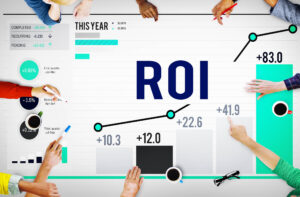Understanding cap rates and ROI is crucial for every woman investor. These metrics can make or break your investment strategy. Cap rates help evaluate property value while ROI measures your profit from rent. Grasping these concepts empowers you to make informed decisions. They are the foundation of smart investing.
In a world where financial independence is vital, knowing these terms will boost your confidence. You’ll be able to analyze deals effectively, including office cap rates, and spot opportunities with the appropriate cap rate and actual cap rate. This knowledge isn’t just for the pros; it’s for anyone ready to take charge of their financial future. Get ready to dive into the essentials that will elevate your investing game.
Key Takeaways
-
Understanding cap rates and ROI is essential for making smart investment decisions in real estate. Familiarize yourself with these metrics to enhance your investment knowledge.
-
To calculate cap rate, divide the property’s net operating income by its purchase price. This simple formula helps you assess potential investment returns.
-
A higher cap rate often indicates a better return on investment but may also signify higher risks. Balance potential rewards with the associated risks when evaluating properties.
-
ROI measures the profitability of an investment by comparing net profit to the initial investment cost. Knowing how to calculate ROI can guide you in choosing the right investments.
-
Aim for a higher ROI by improving property management and reducing costs. Small changes can lead to significant increases in overall returns.
-
Keep in mind that economic factors, such as market trends and interest rates, can impact both cap rates and ROI. Stay informed about these factors to make more strategic investment choices.
Understanding Cap Rate Basics
Definition
Cap rate, or capitalization rate, is a crucial financial metric. It helps investors assess the potential return on an investment property. This metric is calculated by dividing the net operating income (NOI) by the property’s current market value.
For example, if a property generates $50,000 in NOI and has a market value of $500,000, the cap rate would be 10%. This means that the investor can expect a 10% return on their investment annually.
Market Evaluation
Using cap rates allows investors to evaluate similar properties within the same market. By comparing cap rates, one can identify which properties offer better returns. A lower cap rate often indicates higher property values relative to income. Conversely, a higher cap rate may suggest undervalued properties or those in less desirable locations.
Investors should analyze multiple properties before making decisions. For instance, two similar buildings in the same area may have different cap rates due to their rental income or management efficiency. This comparison reveals opportunities for better investments.
Informed Decisions
Understanding cap rates is vital for making informed real estate investment choices. Investors need to know how to interpret these numbers effectively. A high cap rate might attract attention, but it could also signal potential risks like high vacancy rates or maintenance issues.
Moreover, understanding how cap rates fluctuate based on market conditions can guide strategic decisions. For example, during economic downturns, cap rates may rise as property values decline while rents stabilize or fall. Recognizing these trends can help investors time their purchases wisely.
Investors should also consider the overall context of cap rates in their specific market. Local economic factors play a significant role in determining rent prices and property values. An area with strong job growth typically sees lower cap rates due to increased demand for housing.
How to Calculate Cap Rate
Cap Rate Formula
The cap rate formula is simple. It is expressed as:
Cap Rate = NOI / Property Value.
NOI stands for Net Operating Income. This is the income generated from the property after deducting operating expenses. Knowing this formula helps you understand how to measure the profitability of a property.
Gathering Data
To perform accurate cap rate calculations, gather necessary data first. Start with the current Net Operating Income (NOI). This figure comes from rental income minus all operating costs. Next, find the property’s current market price. This value reflects what buyers are willing to pay in today’s market.
For example, if a property generates $50,000 in NOI and has a market value of $500,000, the calculation would be:
Cap Rate = $50,000 / $500,000 = 0.10 or 10%.
A 10% cap rate indicates that the property generates a good return relative to its price.
Consistency in Comparisons
Consistency is key when performing cap rate analysis. Always compare properties within similar categories. For instance, don’t mix residential properties with commercial ones. Different types of properties have different cap rates due to varying risk levels and income potential.
Consider local market conditions as well. A market cap rate can vary by location and property type. This means a “good” cap rate in one area may not be the same in another.
Evaluating Different Cap Rates
Different cap rates indicate varying levels of investment risk and return potential. A low cap rate often suggests a stable investment with lower risk. Conversely, a high cap rate may suggest higher risk but potentially higher returns.
Investors should analyze each property’s unique situation. Look at factors such as tenant stability and future growth potential. These factors can influence both the actual cap rate and perceived value.
Importance of Cap Rate Returns
Understanding cap rate returns helps investors make informed decisions. A strong understanding of capitalization rate measures can lead to better investment choices. Investors should aim for an appropriate cap rate based on their financial goals and risk tolerance.
In summary, calculating cap rates involves using the correct formula and gathering accurate data. Consistent comparisons across similar properties ensure reliable evaluations. Understanding different cap rates allows for strategic investment planning.
Meaning of Higher Cap Rate
Investment Opportunity
A higher cap rate usually signals a better investment opportunity. Investors often look for properties with higher cap rates to maximize returns. The cap rate is calculated by dividing the net operating income by the property price. If the cap rate is high, it suggests that the property generates more income relative to its price.
Higher cap rates can attract attention from various investors. For example, a property with a cap rate of 10% typically indicates a strong income potential compared to one with a 5% cap rate. This difference can guide investors in making informed decisions about where to put their money.
Risk and Returns
Investors must also consider that higher cap rates may come with higher risks. Properties in less desirable areas often have higher cap rates due to increased vacancy risks or lower demand. These factors can lead to fluctuating rental income and property values.
For instance, a property in a declining neighborhood might offer a high cap rate. However, this could signal underlying problems that might affect long-term profitability. Investors should assess market conditions carefully before diving into such opportunities.
Market Conditions
Market conditions play a crucial role in interpreting cap rates. A higher cap rate might be expected in certain markets where growth is slow or uncertain. Economic factors like job growth, population trends, and local amenities impact these rates.
In booming markets, investors may see lower cap rates as prices rise faster than rents. Conversely, in struggling markets, higher cap rates can indicate potential for greater returns if conditions improve.
Understanding these dynamics helps investors make smarter choices. They should analyze both local and national economic indicators alongside cap rates.
Summary of Considerations
Investors should keep several points in mind when evaluating cap rates:
-
A higher cap rate generally indicates better income potential.
-
Higher risks may accompany higher cap rates.
-
Market conditions significantly influence how to interpret these rates.
These considerations are essential for making sound investment decisions. Investors must balance potential returns against the associated risks.
Exploring ROI Fundamentals
What is ROI?
ROI stands for Return on Investment. It is a key financial metric used to evaluate the profitability of an investment over time. Investors calculate ROI to understand how much profit they make compared to the amount invested. This metric is crucial for anyone involved in real estate investing.
Calculating ROI involves taking the net profit from an investment and dividing it by the total cost of that investment. The formula looks like this:
[ \text{ROI} = \frac{\text{Net Profit}}{\text{Total Investment}} \times 100 ]
This calculation provides a percentage that reflects the efficiency of an investment. A higher ROI indicates a more profitable investment.
Cash Flow and Total Investment
ROI considers both cash flow and total investment. Cash flow refers to the income generated from a property, such as rental income from tenants. Total investment includes not just the purchase price but also costs like closing costs, renovations, and ongoing operating expenses.
For example, if you buy a rental property for $200,000 and spend $50,000 on repairs, your total investment is $250,000. If the property generates $30,000 in rental income annually but incurs $10,000 in operating expenses, your net profit is $20,000. Using these numbers:
[ \text{ROI} = \frac{20,000}{250,000} \times 100 = 8% ]
This 8% indicates how effectively your money works for you in real estate.
Comparing Investments
ROI plays a significant role in comparing different rental property investments. Investors can use it to assess various properties beyond just their purchase price. For instance, two properties may have similar prices but vastly different returns based on their rental income and operating expenses.
By calculating ROI for each property, investors can make informed decisions about where to invest their money. This comparison helps identify which properties will yield better returns over time.
Importance of Time
Time is another critical factor when evaluating ROI. The longer you hold an investment, the more potential it has to appreciate in value. Real estate values typically increase over time due to market demand. Therefore, understanding how long you plan to hold a property can impact your overall return.
Loan terms can affect ROI calculations. A shorter loan term may lead to higher monthly payments but lower interest costs over time. Conversely, longer loans might ease cash flow initially but accrue more interest.
Investors should consider all these elements when analyzing ROI for their real estate investments.
Steps to Calculate ROI
ROI Formula
The ROI formula is simple. It states that ROI equals the annual return divided by the total investment. The equation looks like this:
ROI = Annual Return / Total Investment
This formula helps investors determine how well their investments perform. A higher ROI indicates a more profitable investment.
Calculations
Calculating ROI requires understanding your annual cash flow. This means you need to know your operating income. Operating income is the money generated from the property after all operating expenses are deducted.
To find your annual cash flow, subtract all expenses from your total income. Those expenses include property management fees, repairs, and utilities. Once you have your operating income, use it in the ROI formula.
Tracking Costs
Tracking all investment costs is crucial. Include every expense related to the property, such as maintenance and mortgage payments. These costs can significantly affect your net operating income.
Keep detailed records of all transactions. This practice ensures accuracy in calculating ROI. It also helps identify areas where you can save money or improve efficiency.
Example Calculation
Let’s say an investor buys a rental property for $200,000. They collect $24,000 in rent each year but spend $10,000 on expenses. The calculation would look like this:
-
Annual Return: $24,000 (income) – $10,000 (expenses) = $14,000
-
Total Investment: $200,000
-
ROI Calculation: $14,000 / $200,000 = 0.07 or 7%
This means the investor has a 7% return on their investment.
Importance of Accurate Data
Accurate data leads to better investment decisions. Miscalculating ROI can lead to poor choices. Always double-check your figures before making decisions based on them.
Investors should also consider the time value of money when calculating ROI over several years. A higher initial investment may yield lower returns initially but could be more profitable in the long run.
Monitoring Performance
Regularly monitor your investment performance. Adjust your calculations based on changes in income or expenses over time. This keeps your financial goals aligned with reality.
Importance of Higher ROI
Effective Use
A higher real estate ROI indicates a more effective use of invested capital. Investors want their money to work harder for them. A strong return means the property generates more income compared to its costs. This can lead to better overall performance in an investment portfolio.
Higher returns allow investors to reinvest and grow their wealth faster. For instance, if an investor buys a property for $200,000 and earns $20,000 in net income annually, the ROI is 10%. This figure shows that the investment is performing well.
Financing Strategies
Different financing strategies significantly influence ROI outcomes. The down payment percentage plays a crucial role here. A lower down payment can increase leverage but may also increase risk.
For example, suppose you buy a property with a 20% down payment versus a 30% down payment. With a 20% down payment, you borrow more money. If the property appreciates, your ROI could be higher due to the smaller initial investment. However, this strategy comes with risks.
Investors must consider how much debt they carry. Higher debt can lead to higher monthly payments and less cash flow. If rental income decreases, covering these payments becomes challenging.
Caution Against Leverage
Excessive leverage can lead to financial pitfalls. While it might seem appealing to maximize returns, it can backfire quickly. Investors should maintain positive cash flow by balancing their investments wisely.
Using too much borrowed money increases vulnerability during market downturns. If the property value drops or rental demand decreases, investors may struggle to make payments.
To avoid these issues, focus on sustainable financing options. Aim for manageable debt levels that allow flexibility in tough times.
Investors should also evaluate the asking price carefully before making a purchase. A property priced too high can diminish potential returns and affect overall ROI negatively.
Comparing Cap Rate and ROI
Definitions
Cap rate measures the annual return on an investment property based on its current market value. It is calculated by dividing the net operating income (NOI) by the property price. For example, if a rental property generates $30,000 in NOI and costs $500,000, the cap rate would be 6%.
ROI, or return on investment, evaluates the overall profitability of an investment. It considers all costs associated with the purchase and operation of a property. This includes acquisition costs, maintenance expenses, and any renovations made. To calculate ROI, divide the net profit by the total investment cost.
Purpose
Both metrics serve unique purposes in real estate investing. The cap rate provides a quick snapshot of potential returns based on current income. Investors often use it to compare similar properties in a specific market. Higher office cap rates may indicate better returns but can also signal higher risk.
Conversely, ROI offers a broader view. It factors in total costs and gives investors insight into how well their money is working over time. This metric is especially useful for assessing long-term investments or properties requiring significant renovations.
Complementary Insights
Using both metrics together can lead to more informed decisions. While cap rate highlights immediate cash flow potential, ROI reflects overall performance over time. An investor might find a property with a high cap rate but low ROI due to high renovation costs.
For instance, if an investor purchases a fixer-upper at a low price, they may see a high cap rate after repairs. However, if the total investment is significantly high due to renovations, the ROI could be lower than expected.
Investment Goals
Certain scenarios favor one metric over the other. If an investor seeks quick cash flow from rental property returns, cap rate may take precedence. For long-term wealth building, focusing on ROI is essential.
Investors should consider their goals when deciding which metric to prioritize. A property yielding high market rent might have an attractive cap rate but could require substantial management efforts that affect ROI.
Impact of Economic Factors
Interest Rates
Interest rates play a significant role in real estate investments. When interest rates rise, borrowing costs increase. This can lead to higher expenses for investors. Higher costs may reduce cash flow, impacting overall ROI. Conversely, lower interest rates make loans cheaper. This encourages more people to invest in properties. A drop in rates can boost the property market by increasing demand.
Market Demand
Market demand directly affects property prices. High demand often leads to increased prices. Investors should monitor local market trends closely. A strong rental market can enhance income potential. Understanding these dynamics is crucial for maximizing investment returns. Property prices may fluctuate based on economic conditions and consumer confidence.
Economic Trends
Staying informed about economic trends is essential for investors. Changes in the economy can signal shifts in investment performance. For instance, a recession may lead to declining property values. Investors must adapt their strategies accordingly. Recognizing early signs of economic downturns can help mitigate losses.
Adjusting Strategies
Adjusting investment strategies is necessary during changing economic landscapes. Investors should evaluate their portfolios regularly. They need to consider factors such as leverage and cash flow management. Properties that generate consistent income become critical during uncertain times.
Investors might need to diversify their investments as well. This reduces risk and enhances overall stability. Focusing on different markets or types of properties can provide balance.
Expenses Management
Managing expenses is vital for maintaining profitability. Rising costs can eat into an investor’s returns. Keeping track of operational expenses helps identify areas for savings. Efficient property management practices can improve cash flow.
Investors should analyze their financial statements frequently. Understanding where money goes allows for better decision-making.
Rental Market Insights
The rental market also influences cap rates and ROI metrics. Increased demand for rentals can drive up prices and occupancy rates. Investors should pay attention to demographic shifts that affect rental needs. Areas with growing populations often present lucrative opportunities.
Final Remarks
Understanding cap rates and ROI is crucial for every woman investor. These metrics guide your investment decisions, helping you assess property value and profitability. A higher cap rate often signals better returns, while a strong ROI indicates effective investments. Together, they provide a clearer picture of your financial potential.
Now that you’re equipped with these essential tools, take action. Dive into your investment journey with confidence. Analyze properties using these metrics and make informed choices that align with your financial goals. Your success is within reach—embrace it!
Frequently Asked Questions
What is a cap rate?
A cap rate, or capitalization rate, is a metric used to evaluate the profitability of an investment property. It’s calculated by dividing the property’s net operating income (NOI) by its current market value.
Why is cap rate important for investors?
Cap rate helps investors assess potential returns and compare different properties. A higher cap rate indicates a potentially better investment opportunity, making it essential for informed decision-making.
How do you calculate ROI?
Return on Investment (ROI) is calculated by subtracting the initial investment from the final value, then dividing that number by the initial investment. Multiply by 100 to get a percentage.
What does a higher ROI indicate?
A higher ROI signifies more efficient use of capital and greater profitability from an investment. It shows that your money is working harder for you, which is crucial for long-term success.
How do cap rate and ROI differ?
Cap rate focuses on annual income relative to property value, while ROI measures overall profit compared to the initial investment. Both metrics are essential but serve different purposes in evaluating investments.
What economic factors affect cap rates and ROI?
Economic factors like interest rates, local market conditions, and property demand can influence both cap rates and ROI. Understanding these factors helps investors make strategic decisions.
Can women investors benefit from understanding these metrics?
Absolutely! Knowledge of cap rates and ROI empowers women investors to make informed decisions, maximizing their investment potential and fostering financial independence.
 Subscribe to our podcast
Subscribe to our podcast 




